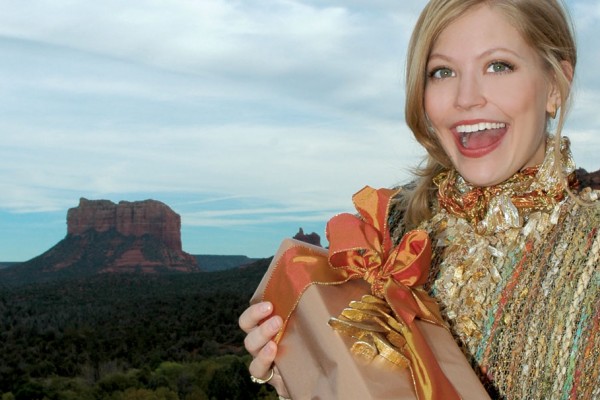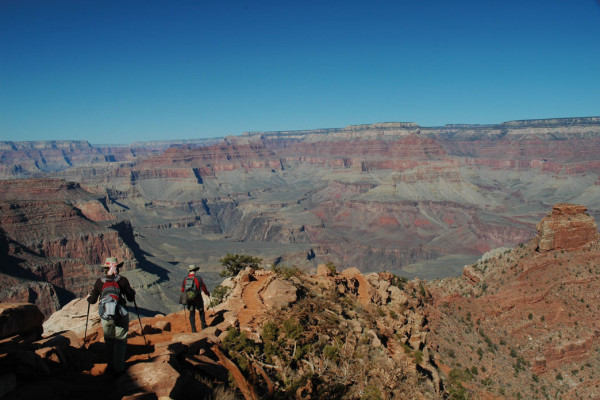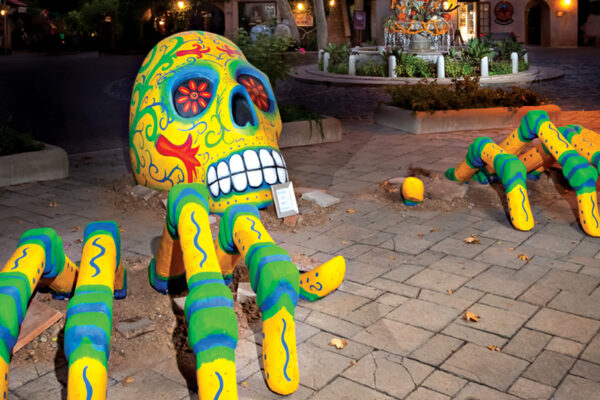Continued (page 2 of 4)
The mountain is located south of Sedona, and it stands out when compared to the surrounding mountains and mesas because it’s composed of white limestone – no red rocks up here. Park at the fence line at the end of FR 9201A, and find a safe place to walk through the cattle fence. Take the faint trail that parallels the fence toward Sacred Mountain. Pass through a cattle guard and a gully, then start the climb up the mountain. About halfway up you’ll find the hikers’ register and a reminder that it’s a federal crime to disturb artifacts thanks to the Archaeological Resources Protection Act of 1979. The trail is narrow with absolutely no shade, so if you’re exploring in the summer months, we recommend hiking in the early morning or evening.
Once you reach the top, footpaths cover the mountain. The ruins, which are really just foundations and low rock walls, are located on the east side of the mountain. Unfortunately, the ruins were ransacked by pot-hunters years ago, so archaeologists haven’t done much excavation work. Whatever you do, don’t disturb any artifacts, walk on the walls or remove rocks. Sacred Mountain is special, and anyone who spends time around the ruins can feel it. During our most recent visit, the silence was startling, the breeze haunting and the late-afternoon light mesmerizing. It’s not hard to figure out why the Sinagua chose this location to build a pueblo.
Directions: Take SR 179 south, drive under I-17 and continue on FR 618. Go left on FR 9201A, the first left past V-Bar-V Heritage Site. FR 9201A is rutted and rocky – you’ll need a high-clearance and/or four-wheel-drive vehicle. Park at the fence line. A Red Rock Pass is required for parking; passes are not sold at the trailhead. For further info, call the Red Rock Ranger District at 928-203-2900.
Hidden Tour
We know: You’ve been to Palatki, Honanki and V-Bar-V heritage sites so many times you could practically conduct your own tours. But have you ever scheduled the Agave Roasting Pit Tour at Palatki? The half-mile round-trip ranger-led hike leads to an interesting mound where the Yavapai (primarily) and Sinagua people roasted agave leaves. In order to eat the fibrous plants, the Yavapai and Sinagua would suck out the sugars and spit out the fibers. Small balls of the chewed fibers, called quids, litter the mound. The pulp from the leaves would be scraped out on shiny, smooth processing rocks located in the grotto behind the mound. The grotto itself is covered with interesting red, black and white pictographs. We thought we knew all the rock art in Sedona by heart, but we found symbols here we’d never seen before, including a prayer stick, lines of people, a mask and a circle divided into four quadrants that just happens to be the symbol of the Red Rock Pass. Our tour guide, Cultural Resource Site Supervisor Terrilyn Green, pointed out other similar pictographs that had been partially rubbed out. It left everyone on our tour musing about the significance of the ancient symbol.
Next to the grotto is a crack in between two rocks that Terrilyn says Native Americans call the spirit door. An archaic ghost-like pictograph and another image that resembles a chain are painted next to the door. The mostly shaded trail leading to the pit passes a spring and homestead ruins, and a portion of it passes underneath a waterfall (which was dry during our visit, but Terrilyn says it’s quite the sight during the rainy season). The site was open to the public until about five years ago when problems with graffiti forced the Forest Service to close the trail. Stay out of the agave roasting pit, be mindful of the processing rocks and don’t touch the rock art so everyone can continue to enjoy the site.
Directions: Go south on SR 89A past Sedona and turn left on FR 525. Take the gravel road north for seven miles. Palatki is open by reservation daily from 9:30 a.m. to 3 p.m. The Agave Roasting Pit Tour usually takes place at 10 a.m. and 2 p.m., depending on the number of staff present. The tour is limited to 12 people. Make sure you call in advance to verify the tour will take place the day you’d like to visit. Red Rock Passes are required for parking. Pets are not allowed. To make reservations or check road conditions, call 928-282-3854.
Hidden Hollywood History
It’s nothing short of amazing, and more than a little disappointing, that so many Sedona film experts have forgotten the still-standing Sedona location of Paul Mazursky’s Harry and Tonto, especially when you consider the 1974 flick is the only movie with scenes filmed in Sedona to have won an Academy Award (Best Actor in a Leading Role). Art Carney, best known for his role as “subterranean sanitation engineer” (or sewer worker) Ed Norton in The Honeymooners and The Jackie Gleason Show, won the Oscar as well as a Golden Globe in 1975. In the sentimental comedy, Carney plays 72-year-old Harry, who sets out on a cross-country trip with his orange cat, Tonto, after his New York apartment is demolished. After Tonto kicks up a fuss about traveling via airplane and Greyhound Bus, Harry purchases a car (even though his driver’s license expired in 1958) and proceeds to drive to Chicago to see his daughter (played by Ellen Burstyn). When things go sour in the Windy City, he heads west and makes a brief stop in Sedona.



